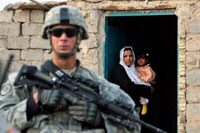Chinese Publication Seeks Guidance from HTS Program Manager
by John Stanton

Before linking JIEDDO to Furlong’s program, it’s worth noting that the US Army Human Terrain System is in the midst of an Army 15-6 investigation. According to sources one area the investigator is looking at is the “management/leadership side and fraudulent time and attendance records.” Many in the program have high hopes for positive change.
Cultural Operations Research - Human Terrain System (COR-HTS) -- now simply HTS -- was originally funded by the Joint Improvised Explosive Device Defeat Organization (JIEDDO). Coincidently, JIEDDO was formerly under the command of Steve Fondacaro, who now runs the turbulent HTS program. JIEDDO received a punishing audit by the Government Accountability Office.
The GAO described JIEDDO as an ad hoc organization that did not identify, track or report all contractor personnel, and sorely lacked accounting controls. Those activities allegedly have found their way into the HTS program.
The Washington Post was correct on its JIEDDO findings and JIEDDO was a good place to bury Furlong's program. Furlong confirmed the funding for his effort came through JIEDDO.
Sanlian Lifeweek
Pu Shi, a journalist for Sanlian Lifeweek Magazine in Beijing, has requested contact information for HTS personnel. The purpose is to explore issues associated with the alleged US government sponsorship of a private contractor assassin program allegedly run by Robert Furlong formerly of STRATCOM. Contractors perform every military task imaginable (even Personnel Recovery) so what's the rub with hiring them to kill/capture undesirables?
At any rate, Pu Shi found this email address cioran123@yahoo.com (mine) in a message string at Men's Journal. "I found this email address at this website in the hope of finding Dr. Steve Fondacaro and staff [at] HTS. Please forward the email to Dr. Steve Fondacaro at your convenience."
Famed journalist/author Robert Young Pelton had written an article on the Human Terrain System in February 2009 for MJ that caused a bit of controversy and a considerable amount of discussion. Steve Fondacaro, Program Manager of HTS, and Montgomery McFate, Senior Social Scientist, were incensed about the story and wrote to Men's Journal questioning Pelton's professionalism. One point of contention was Pelton's assertion that the information collected by HTS could be used for a variety of purposes by US Army Brigade Commanders. One such use of that information is as intelligence that ultimately makes its way into the Kill Chain.
Pelton was absolutely correct on that point. But why does Pelton think his information was immune to finding its way into the Kill Chain? Given his survivalist background, it is extraordinarily difficult to accept that he was “tricked” by a 56 year old bureaucrat in the USA.
Pu Shi requested an interview with "Dr." Steve Fondacaro and "staff" at HTS. That request was received on 16 March 2010 at roughly 6:45 PM (Eastern). I responded by pointing out that using me as a circuit to get to Mr. Fondacaro was ill-advised. But I did provide Pu Shi with the link to the Contact section of the HTS.mil website. I also offered other resources on HTS (pro-con) and suggested looking at the Washington Post's coverage of the Furlong matter.
Four Questions for HTS Management
"To whom it may concern, I am a Chinese journalist working with Sanlian Lifeweek, one of the most widely circulated weekly magazines in China with 300,000 readers per week in more than 30 Chinese big cities. It is published by Sanlian Publishing House of China Publishing Group. Sanlian Publishing House was founded in the 1930s and is one of China's largest publishing houses of long history. One of our topics this week is Mr. Michael D. Furlong's private intelligence network and the role private contractors play in intelligence gathering in Afghanistan. We would really appreciate if he could kindly share your opinions with us. The interview questions are as follows, for his reference:
1. How and why has the former Army official, Michael D. Furlong's private security network come into the attention of C.I.A. and the media? Does the surface of this episode imply some of the problems with intelligence work in Afghanistan and Pakistan?
2. Mr. Furlong is said, according American officials, to be using the network to gather intelligence to target militants and the location of insurgent camps, and the information was then sent military units and intelligence officials for possible lethal action in Afghanistan and Pakistan. And the top military told the N.Y.Times that the intelligence collection is originally intended to gain a deeper understanding of the country and society. How is intelligence gathering targeted at militants and targeted at understanding a country different? How do you think Mr. Furlong's work can be identified as tracking and killing militants?
3. What role do private contractors and companies play in intelligence gathering in Afghanistan, Pakistan, Iraq and by large, in wars? Where is the line between the field of professional contractors and journalists and the field of military intelligence?
4. It seems that there have been frictions between the army and the freelancers in Afghanistan for long. What is behind these frictions?
Our press time is on Sunday midnight (we are 12-13 hours ahead of you). We would really appreciate if he could accept our interview. Thank you very much and we anticipate your reply!"
A Thousand Flowers Blossom From JIEDDO/HTS Efforts
This item appeared in a 2009 publication by the Rapid ReactionTechnology Office titled Experimentation and Rapid Prototyping in Support of Counterterrorism. Note that many aspects of HTS are being used for intelligence purposes. Many within HTS have argued all along that HTS is an intelligence effort.
Quoting directly from the publication:
SKOPE is a joint intelligence cell with the National Geospatial-Intelligence Agency (NGA), SOCOM, and the U.S. Strategic Command (STRATCOM). It began with a specific request for sensors to help narrow the search space for terrorists and terror groups. The RRTO recommended the development of the SKOPE approach and was the sole funding source for the initial operating capability of the analytic cell. Currently the RRTO is developing new tools in response to specific requests from commanders based on the success and experience with this operational capability.
The SKOPE cell applies all-source, multi-intelligence analysis linked to a spot on Earth. Through its application of human terrain analysis, SKOPE incorporates aspects of the Human Terrain System (HTS), a new proof-of-concept program run by the U.S. Army Training and Doctrine Command and serving the joint community. The near-term focus of the HTS program is to improve the ability of the military to understand the highly complex, local sociocultural environment in areas of deployment. In the long term however, it is hoped that HTS will assist the U.S. government in understanding foreign countries and regions prior to an engagement within a region. According to the Army Web site, the HTS program represents the first time that social science research and advising have been done systematically, on a large scale, and at the brigade level.
John Stanton
Subscribe to Pravda.Ru Telegram channel, Facebook, RSS!


